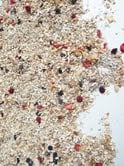Nicole Wermers – Food in space

Mostra personale
Comunicato stampa
What shape is this text?
Everything is designed. The chair I am sitting on, the clothes I’m wearing, the computer I’m typing on, the table where it lays on, and the mobile phone next to it. Even I, myself, have been designed. Even the exhibition this text is referring to has been designed, of course. Nicole Wermers is certainly aware of it, and many of her works deal with this: re-designing what has already been designed and of which, however, we limit ourselves to passively notice its existence, as if it was sent down from heaven.
As Luciano Fabro once said: “Art is the artifice that agrees with the state of nature”. This means it does not give up abdicate to the charm and the attractiveness of the materials and their combination and re-use. The nature of the artworks on display seems to have its source from a wellspring of phenomena, situations, and objects which have been first observed and then reformulated into art — which is at the end a process of transformation.
In this case the inspirations and the elements “under observation” could be summarized as follows: interior design magazines, pastry shop windows, the daily process of customizing one’s muesli as well as the continental breakfast served in hotels.
These are the suggestions that will lead to the final result, which is the exhibition itself.
Within an exhibition space of modest dimensions that overlooks a lovely street in Rome’s historical city center, two shelves are placed or, more precisely, two showcases with edible pastries on display. Each shelf has a different shape, just like the pastries on top of them. They are both placed on two parallel walls at approximately 1,5 meters above ground level. Both the shelves and the sweets have been designed by the artist and realized by local craftsmen.
During the entire duration of the exhibition, the pastry display will be replaced by a display of muesli which will adopt the function of “nightdecoration” (normally a term for a a night-time substitute of valuable goods in shop windows).
Like most sculptures or installations created by Nicole, they take on different connotations depending on our viewpoint.
If we look at them from the perspective of visual arts, they look like sculptures which remind us of minimalist or constructivist works.
If we look at them from the perspective of a trader, they can look like ambiguous displays.
If we look at them from the perspective of a design enthusiast, they remind us of ‘90s furniture design.
If we look at them from the perspective of a dog, they look like something to bark at or to try to grab with our paws.
If we look at them from the perspective of a 5-year-old child, they look like a forbidden pleasure you cannot resist.
From my point of view, on a formal level, these artworks are influenced by modernism, while, on a conceptual level, they represent a reflection on the meaning of aesthetics in the contemporary world.
Consumer goods, just like artworks, function also as language. They have been created and designed for a specific audience and, just like words, underlie any interpersonal relationship. Wermers’ work starts from here: from the environment surrounding us and from the objects that inhabit it. Unlike Haim Steinbach, whose works could be easily compared to Nicole’s, she never uses found objects that have been extracted from everyday life. Instead Wermers is much more interested in the display itself rather than in the displayed object. The question behind her work is not why something does exist, but how it is displayed. By changing the method of display — either formally or structurally — and by completely transforming the object in question — be it a shelf, pastry, a metal detector or an ashtray — the artist makes a shift that leads the observers to wonder.
This also happens with the works on display here: at first sight they look familiar, but if you take a closer look, they are not. Both the shelves and the pastries induce pleasure and desire to the sight and mind of the observers. Take the shelves, for example, their surface is clean, linear, shiny, and smooth. They are charming not least because of their ambiguous and contradictory nature: they are functional objects if we consider them as supports and displays, at the same time they are inadequate as works of art.
Don’t think too much, look at them, walk around them, try to imagine their structure and the taste of the sweets, and do not forget that each object is never neutral in its form or content. Just like this text.
Luca Lo Pinto



